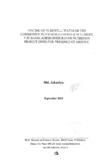Testing of tubewell water of the Community Nutrition Centres (CNC) under the Bangladesh Integrated Nutrition Project (BINP) for presence of arsenic
Date
2002-09Publisher
BRAC Research and Evaluation Division (RED)Author
Jakariya, Md.Metadata
Show full item recordCitation
Jakariya, M. (2002, September). Testing of tubewell water of the Community Nutrition Centres (CNC) under the Bangladesh Integrated Nutrition Project (BINP) for presence of arsenic. Research Reports (2002): Health Studies, Vol - XXXIII , 13–54.Abstract
Bangladesh faces multi-faceted problems in relation to groundwater. At present there is a new
threat - arsenic contamination in groundwater. Arsenic is a shiny, grey, brittle element possessing
both metallic and non-metallic properties (Train, 1979). The source of arsenic in drinking water
is geological. Arsenic occurs naturally in the sediments of Bangladesh bound to amorphous iron
oxyhydroxide. However, there are lots of controversies over the origin of arsenic in the
groundwater.
Bangladesh achieved remarkable success in providing safe drinking water to almost 97% of its
rural population. But the recent discovery of arsenic in groundwater has ruined this decade-long
success and the access to safe drinking water has now dropped to almost 80% (UNICEF, 1999).
To mitigate the arsenic problem, a number of alternative safe water options are available in
Bangladesh. Some of these options are based on surface water and some are based on treating the
arsenic-contaminated water.
Malnutrition, which is a serious health concern in Bangladesh and poor socio-economic
conditions aggravate the hazards of arsenic toxicity. The recent remarkable strides achieved in
the health sector in Bangladesh have been slow down in the reduction of malnutrition (lahan and
Hossain, 1998). Fifty percent of the country's child mortality is reported to be associated directly
or indirectly with malnutrition CBBS, 1994). The Bangladesh Integrated Nutrition Project (BINP)
is the first major attempt of the government of Bangladesh to develop a comprehensive well coordinated
inter-sectoral programme financially supported by the World Bank (The World
Bank, 1995).
Tubewell water is the only source of water for drinking and mixing the supplementary food at
the CNCs for the pregnant women and children. Therefore, it is important to check tubewells of
all the CNCs for presence of arsenic and subsequently to arrange alternative safe water options,
if tubewell water is contaminated with arsenic at a dangerous level (i.e. >50~1). Accordingly,
tubewell water of all the CNCs were tested with MERCK field testing kit and it was observed
that only 26% tubewells found to be contaminated with arsenic more than the acceptable limit for Bangladesh. Ullfortunately, it was observed that these contaminated tubewells were using for
preparing food at the CNCs.
in order to develop the mitigation plan for the arsenic affected CNCs it is important to assess the
average daily requirement of water by members of each CNCs to develop mitigation plans. It
was observed that the daily requirement of water of almost all the CNCs was within the range of
20 litres per day, which means either small community-based option or household unit with good
flow rate could be the suitable alternative safe water options for the arsenic affected CNCs.
An attempt was made to check the source of drinking water of the CNC members at their home,
since they spend only a few hours at CNCs. It was observed that drinking water source of more
than 80% CNC members at home is tubewell water and their arsenic status was not known the
owners at the time of testing.
Focus group discussions were organized at the arsenic contaminated CNCs to get an idea about
their preferred mitigation methods. Among the options preferred by the respondents deep hand
set tubewell was found to be the most popular options (42%) followed by three-pitcher filters
(25%). Since there is no curative measure for this disease except drinking arsenic-free waler
(Smith 2002), alternative suitable safe water options should be made available without any delay
for the exposed pregnant women and children from further exposure to arsenic contaminated
water.

